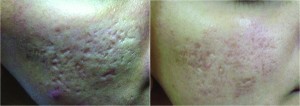Fractional radiofrequency with microneedling in acne scars
Acne can result in a variety of subtypes of scars; depending on the depth and severity of the inciting inflammation. Atrophic scarring limited to the epidermis and papillary dermis results in superficial macular scarring, which may be erythematous or hyperpigmented16. Involvement of the reticular dermis can result in ice-pick scars, boxcar scars, rolling scars, hypertrophic scars, and keloids11,12. Ice-pick scars have a narrow aperture and penetrate deep into the dermis or subcutaneous tissue. Boxcar scars have sharp cliff-drop-like vertical margins and a larger, flatter base. Boxcar scars can be further subdivided into superficial and deep boxcar scars. Rolling scars occur from dermal tethering to the underlying superficial musculoaponeurotic system, with the appearance of gently sloping edges12.
Chemical peels, subcision, augmentation using dermal fillers, ablative and non-ablative lasers, dermabrasion, dermal grafting, punch excision, punch elevation, punch grafting, and surgical excision are all available for the treatment of acne scarring11–13. The following lasers have also all been applied for acne scarring:
-
Pulsed dye laser14
-
Non-ablative 1064 nm Nd:YAG15
-
Non-fractionated 1320 nm Nd:YAG
-
Non-fractionated 1450 nm diode14,16
-
Erbium-doped lasers (1410 nm, 1540 nm, and 1550 nm)
-
Fractionated 1320/1440 nm
-
Fractionated 2940 nm Er:YAG laser
-
Fractionated 10600 nm CO2 laser17.
The standard treatment for acne scarring is traditional, full-face CO2 or Er:YAG laser resurfacing, with studies showing more favourable results with CO2 lasers18. The non-fractionated, high-energy, pulsed CO2 laser improves acne scars by an average of 80% with a single treatment18. Although ablative laser resurfacing produces the most dramatic improvement in acne scarring and texture, there is a significant risk of dyspigmentation, scarring, infection, and prolonged healing19.
The first publication on fractionated laser resurfacing was by Manstein et al in 200420. Fractional photothermolysis had the advantage over ablative laser resurfacing owing to a shorter recovery, lack of general anaesthesia, and lower risk of scarring, dyspigmentation, and infection13. Although originally described for rejuvenation of the ageing face, this concept was soon applied to acne scarring. In a small cohort of skin types IV–VI, 80% of patients had a minimum of 50–75% improvement in acne scarring after five treatments over a 1-month period using the fractionated 1550 nm erbium-doped laser21.

Figure 1 Active acne and acne scar (left) before and (right) after three treatments with microneedle radiofrequency
A meta-analysis reported that acne scars improved at least 50% with four to five treatments per month using a fractionated non-ablative laser22. After the development of fractionated non-ablative lasers, fractionated ablative lasers emerged. Cho et al23 found an average of 60% improvement after a single treatment with a fractionated CO2 laser, and in a study by Chapas et al24, two to three treatments with a fractionated CO2 laser improved acne scarring by an average of 66.8%.
Peterson et al25 reported improvements in acne scarring and texture of more than 60% with five treatments per month using a combination of fractionated laser with RF device and a fractionated bipolar RF device. The improvement of scarring is comparable with those of other non-ablative fractionated lasers. Rolling scars and boxcar scars improved more dramatically than ice-pick scars25.



